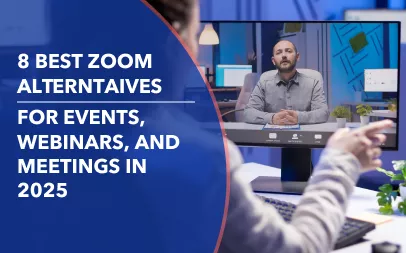
In today's digital age, webinars have become a popular method of communication and learning. But what exactly is a webinar? In this article, we will explore the meaning of a webinar, its evolution, its importance in today's world, how to participate in one, and the future of webinars.
Understanding the Concept of a Webinar
In today's digital age, the concept of a webinar has revolutionized the way seminars and presentations are conducted. With the advent of web-based technology, participants from different locations can now connect and interact in real-time, breaking down geographical barriers and expanding the reach of knowledge-sharing. Let's delve deeper into the fascinating world of webinars and explore their origins.
The Definition of a Webinar
At its core, a webinar is a web-based seminar or presentation that allows participants to engage in a virtual learning environment. The word "webinar" is a clever combination of "web" and "seminar," highlighting the online nature of this innovative communication medium. Unlike traditional seminars that require physical presence, webinars enable individuals to attend and actively participate from the comfort of their own homes or offices.
Webinars typically involve a host or presenter who delivers the content, supported by visual aids such as slides, videos, and interactive elements. Participants can join the webinar by accessing a dedicated online platform or through video conferencing software. This dynamic format allows for real-time engagement, including live chat, Q&A sessions, and interactive polls, enhancing the overall learning experience.
The Origin of the Term 'Webinar'
The term "webinar" was first coined in the early 1990s by a pioneering company. Back then, they introduced their innovative online conferencing software, which revolutionized the way virtual meetings and presentations were conducted. This groundbreaking technology enabled users to connect and collaborate remotely, bridging the gap between individuals separated by vast distances.
As online conferencing software gained popularity, so did the term "webinar." It quickly became the go-to phrase to describe any virtual event held over the internet. Today, the term has become ingrained in our digital vocabulary, synonymous with web-based seminars, workshops, training sessions, and conferences.
Webinars have become an indispensable tool for businesses, educational institutions, and organizations worldwide. They offer numerous advantages, including cost-effectiveness, flexibility, and scalability. With just a computer and an internet connection, participants can access valuable insights, learn new skills, and connect with experts from various fields, regardless of their physical location.
Furthermore, webinars have become a valuable platform for thought leaders, industry experts, and influencers to share their knowledge and engage with a global audience. By harnessing the power of technology, webinars have democratized education and professional development, making learning accessible to anyone with an internet connection.
In conclusion, webinars have transformed the way we learn, collaborate, and share information. They have opened up new possibilities for remote education, virtual conferences, and interactive presentations. As technology continues to advance, we can only expect webinars to evolve further, empowering individuals and organizations to connect, learn, and grow in the digital realm.
The Evolution of Webinars
Webinars have come a long way since their inception, transforming from basic presentations to interactive and engaging virtual events. Let's take a closer look at the early days of webinars and the impact of technology on their evolution.
The Early Days of Webinars
In the early days, webinars were relatively basic in terms of technology and functionality. They mostly consisted of a presenter sharing their screen or slides while delivering a presentation to remote participants. These webinars provided a convenient way for individuals to attend educational or informational sessions without the need for physical attendance.
However, as technology advanced, so did webinars. The introduction of audio and video capabilities allowed presenters to deliver their content in a more engaging manner. Participants could now see and hear the presenter, making the webinar experience feel more personal and interactive.
Additionally, early webinars often lacked the interactive elements that are now commonplace. Participants had limited opportunities to engage with the presenter or ask questions. The focus was primarily on delivering information rather than fostering collaboration and discussion.
The Impact of Technology on Webinars
The evolution of technology has greatly enhanced the webinar experience. Today, webinars can include features such as live video streams, interactive polls, chat boxes for audience engagement, and even breakout rooms for group discussions. These advancements have made webinars more engaging and interactive for both presenters and participants.
Live video streams have revolutionized webinars by allowing presenters to connect with their audience on a more personal level. Participants can now see the facial expressions, body language, and gestures of the presenter, adding an extra layer of communication and understanding.
Interactive polls have also become a popular feature in webinars, allowing presenters to gather real-time feedback from participants. These polls can be used to gauge audience opinions, test knowledge, or simply add an element of fun and interactivity to the session.
Furthermore, chat boxes have transformed webinars into dynamic and collaborative spaces. Participants can now ask questions, share insights, and engage in discussions with both the presenter and other attendees. This interactive element fosters a sense of community and creates a more immersive learning experience.
Lastly, breakout rooms have expanded the possibilities of webinars by enabling participants to engage in smaller group discussions. This feature is particularly useful for workshops or training sessions where participants can work together on activities or brainstorm ideas.
In conclusion, webinars have evolved from basic online presentations to interactive and engaging virtual events. The advancements in technology have not only enhanced the webinar experience but also transformed it into a dynamic and collaborative learning environment. As technology continues to advance, we can expect even more exciting developments in the world of webinars.
The Importance of Webinars in Today's World
Webinars have revolutionized various aspects of our lives, from education to business. They have broken down geographical barriers and opened up a world of possibilities for individuals and organizations alike.
Webinars in Education
In the field of education, webinars have transformed the way students and teachers connect and learn. Regardless of their physical location, individuals can now participate in virtual classrooms and benefit from the expertise of educators from around the globe.
With webinars in education, distant learning has become a reality. Students who were previously limited by their location now have access to a wide range of educational opportunities. They can attend virtual lectures, participate in interactive discussions, and collaborate on projects with peers from different parts of the world.
One of the most significant advantages of webinars in education is the ability to bring in guest lecturers from various fields. Experts who may not have been able to physically visit a classroom can now share their knowledge and insights through webinars. This enriches the learning experience for students, exposing them to diverse perspectives and cutting-edge research.
Webinars in Business
In the business world, webinars have become an indispensable tool for marketing, training, and customer engagement. Companies of all sizes can leverage webinars to reach a global audience, showcase their products or services, and establish themselves as industry leaders.
Webinars provide an effective platform for businesses to educate their customers. Companies can host webinars to provide in-depth product demonstrations, share industry insights, and address frequently asked questions. This not only enhances customer understanding but also builds trust and credibility.
Moreover, webinars are an excellent resource for employee training. Companies can conduct remote training sessions, ensuring that their workforce is equipped with the necessary skills and knowledge. This is particularly beneficial for organizations with geographically dispersed teams, as it eliminates the need for costly and time-consuming travel.
Another advantage of webinars in business is the ability to conduct virtual meetings with clients. Instead of traveling long distances for face-to-face meetings, businesses can now connect with clients through webinars. This saves both time and resources while maintaining effective communication and fostering strong business relationships.
In conclusion, webinars have become an integral part of our modern world, transforming education and revolutionizing business practices. They have broken down geographical barriers, enabling individuals and organizations to connect and collaborate regardless of their physical location. With their cost-effectiveness, efficiency, and ability to reach a global audience, webinars have proven to be an invaluable tool in today's society.
How to Participate in a Webinar
Webinars have become increasingly popular as a way to connect with others, learn new skills, and share information. Whether you're attending a webinar for professional development, educational purposes, or personal interest, it's important to know how to participate effectively. In this guide, we will explore the necessary tools for joining a webinar and the etiquette you should follow to ensure a smooth and productive experience for everyone involved.
Necessary Tools for Joining a Webinar
Before you can participate in a webinar, you will need a few essential tools. The first requirement is a computer or mobile device with internet access. This allows you to connect to the webinar platform and access the content being presented. Most webinars can be joined using a web browser, such as Google Chrome, Mozilla Firefox, or Safari. However, some webinars may require specific software or plugins to be installed on your device. It's crucial to check the webinar invitation or website for any technical requirements or instructions ahead of time.
In addition to a computer or mobile device, you may also need a stable internet connection. A slow or unreliable internet connection can lead to disruptions during the webinar, such as audio or video lag. To ensure a smooth experience, consider using a wired internet connection or sitting close to your Wi-Fi router.
Etiquette for Participating in a Webinar
Participating in a webinar requires following proper etiquette to create a conducive learning and sharing environment. Here are some essential tips to keep in mind:
1. Mute your microphone when not speaking: To minimize background noise and distractions, it's important to mute your microphone when you're not actively speaking. This allows the presenter and other participants to focus on the content being shared. Most webinar platforms provide a mute button that you can easily toggle on and off.
2. Use the chat function respectfully: Many webinars have a chat function that allows participants to ask questions, share insights, or engage in discussions. When using the chat, be respectful and considerate of others. Avoid spamming the chat or posting irrelevant comments. Instead, use it as a tool to enhance the learning experience by asking thoughtful questions or contributing valuable information.
3. Be attentive and engaged: Treat a webinar as you would an in-person event. Be present and actively engage with the content being presented. Avoid multitasking or getting distracted by other activities. Take notes, ask questions, and participate in any interactive elements, such as polls or quizzes. Your active participation not only benefits your own learning but also contributes to the overall success of the webinar.
4. Respect the presenter and other participants: Show respect towards the presenter and fellow participants by listening attentively and refraining from disruptive behavior. Avoid interrupting the presenter or speaking over others. Remember that webinars are a collaborative learning environment, and everyone's input and opinions should be valued.
By following these etiquette guidelines, you can make the most out of your webinar experience and contribute to a positive and engaging virtual environment.
The Future of Webinars
Predicted Trends in Webinar Technology
As technology continues to advance, we can expect further enhancements in webinar technology. Some predicted trends include augmented reality (AR) and virtual reality (VR) integration, which would provide an immersive and interactive experience for webinar participants. Additionally, improvements in video and audio quality, as well as real-time translation services, may further enhance the global reach and accessibility of webinars.
The Role of Webinars in a Post-Pandemic World
The COVID-19 pandemic has accelerated the adoption of webinars, with many conferences, events, and meetings moving online. Even in a post-pandemic world, webinars are likely to continue playing a significant role. They offer convenience, flexibility, and cost-saving benefits that make them an attractive option for various industries and fields.
In conclusion, webinars have become an integral part of modern communication and learning. They have evolved from simple online presentations to interactive and engaging experiences. Whether used in education, business, or other sectors, webinars have proven their value in connecting people across distances and providing opportunities for collaboration and knowledge exchange. As technology advances, we can expect webinars to further transform and shape the way we communicate and learn.
Like what you see?
Inspired to take your webinars and virtual events to the next level? Unlock the full potential with Remo's cutting-edge platform Elevate your gatherings with Remo's dynamic features. Sign up today and embark on a journey of unforgettable connections and growth! Book a demo today!




























